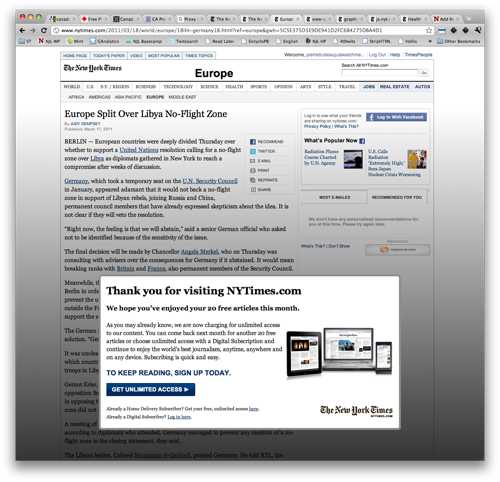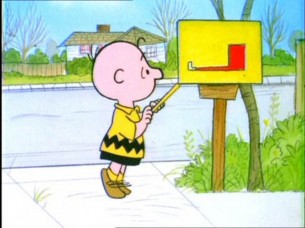If you’re a news junkie, use Twitter or have somehow landed on this website, you’ve no doubt already heard about the New York Times pay wall finally coming online.
Months of planing, fixing glitches around the clock to the last hour and at a cost of nearly $40 million to $50 million.
Publishers and media moguls have been watching and waiting with a keen eye to see if readers will pay for something they’ve become accustomed to getting for free since the internet started entering homes in the mid 90s.
Back then and before, as you’ll see in the video from 1981 below, no one expected the internet to compete with or cannibalize the print product.
Now of course we know different now, well, not we, I was just a kid back then.
It remains to be seen how the pay wall will play out. If folks will enter through a drawbridge instead of running across the field.
Already intrepid readers are finding ways to get around the wall, some in as little as four lines of Javascript others with the stroke of the delete key.
As Nieman Journalism Labs reports the code work around comes from a flaw in the way pages are pulled up in the NYTs wall.
Once the 20 free article limit is reached the 21st article loads like normal but is quickly screen masked with a “please subscribe” message. The article is still legible for the most part and there are literally half a dozen work around out there.

A Civilized Pay Wall
But is a flaw? I highly doubt it.
The Times has to know about the “flaw” or else the page wouldn’t be so forgiving to bandits. They’re treating it more like a subscription card in a magazine then something out of the house of Murdoch or the old Slate.com model.
Then’s there are the intentional holes left open for social media. Users visiting through Twitter, aggregators, search engines, Facebook and other social sites won’t have those clicks count against the 20 article limit. In essence, casual users have unlimited access. And this is why the model of the NYTs pay wall is a good thing.
It shows respect for readers and understands the web and still takes advantage of the referral traffic that comes its way every day in droves. A civilized pay wall if you will.
Journalism doesn’t have Hollywood lobbyist
The NYTs has obviously learned something that the RIAA and MPAA can’t get through their head. That once something is online, it’s online forever. And second, that people will find a way to get what they want no matter how you try to stop them.
The Times built the wall with enough holes in that anyone who really doesn’t want to pay, can with a couple of clicks, read it anyway.
There’s no doubt in my mind that this is intentional on their part.
But it still won’t work.
TimesSelect already showed us that people won’t pay. Newsday may have destroyed itself by only garnering 35 subscriptions in 3 months. Across the country many papers have experimented with pay walls and nearly all have failed or are running at a reduced capacity.
The hope is the Times is big enough that if anyone can do it, they can, but they won’t. At least they won’t meet their monetary goals.
But what about the Wall Street Journal you might say.
True, but the Times isn’t selling a specialized product that you can only get from them. They’re selling and producing news at large. Granted it’s a breath of news arguably above the rest, but not many readers value that these days. You can argue that I’m making quite an assumption, but it’s one I stand by.
All for One
The bigger conundrum is that we know people won’t pay for something they can get for free elsewhere.
I’m not pointing the finger at aggregation, The Huffington Post or Google News, I’m pointing the finger at the rest of the industry.
For pay walls to work it has to be an all or nothing approach across the industry.
If I can still go to The Washington Post and LA Times for my national news and the San Jose Mercury News for my tech news and The Oregonian for environmental news and so on all for free, well, I’m going to go there. Or even easier, I’m going to go to my favorite aggregate on those topics because it’s easier and it’s still free.
But if the entire industry decided to create pay walls, then I’d have little choice but to pay for the publications I wanted to read. It becomes more like the tablet model with I have to fill my menagerie with the glass animals I want.
Or even better, if the industry decided to create a “one pass” subscription which allowed me a user name and password in a system like MMORPGs, XboxLive or Facebook login enabled websites, that gave me access to every newspaper website.
I am obviously side-stepping the merits of making journalism available for the public good, but that’s a deep ethical debate for another article.
Chutes and Ladders
The genius of the NYTs move isn’t that they’re charging for the news. It’s all the loopholes they left in and how lax they are about asking for money…. it sends the message to readers that news has a value and they would appreciate it if you helped pay for it…. it’s less arm twisting and more transparent and approachable.
As if the Times is saying, “Hey readers, this cost money, you know newspapers are in trouble, don’t you think we’re worth it, why not pitch in a little?”
I’m okay with that.



